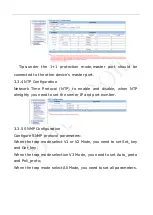
TDM Pseudowire Access Gateway corresponding TDM Pseudowire
Access Gateway,If the time slots settings of both sides are the same
in TDM Pseudowire Access Gateway mode.
(10) Check that the transmission network has enough bandwidth.
It can be judged by the growing number of NMS data buffer empty.
(11) Check that whether the jitter from network is too large, to
judge by the number of NMS data buffer empty and full. If the
network jitter is too large, we can determine it is true or not by
setting the jitter buffer size.
(12) Check for E1 alarms, whether the local E1 cable dropped or
poor contact or line broken. If there is a local LOS alarm, please
check whether the end of E1 cable is dropped or poor contact or line
broken.
(13) Both ends of the gateway are set to the differential clock
mode, but common clock source does not exist.
A.1 Downstream reporting slips
Check the timing mode settings of FE1 over GE. Whether both sides
of the E1 in the asynchronous state. If there is no public reference
clock source, FE1 over GE device timing mode must be set to adaptive
timing mode, both ends cannot work in loopback timing mode.
At the transition time after power on or reapplying the E1 signal, slips
and errors are acceptable. Such transition may take several minutes.
If it slips for a long time, further analysis is required to find out the
reasons. And it may be caused by one or several reasons:
(1) The transmission network does not have enough bandwidth. It
can be judged by the growing number of data buffer empty.




















